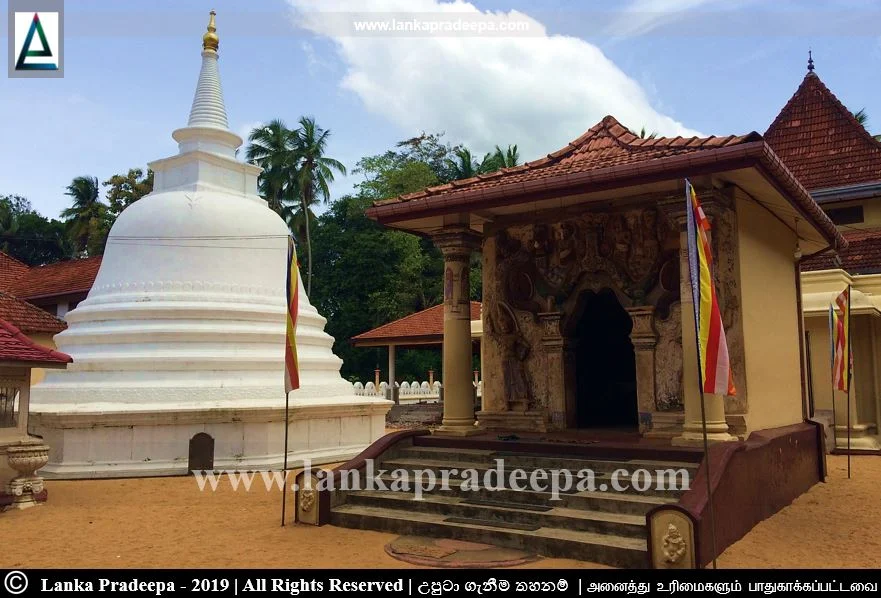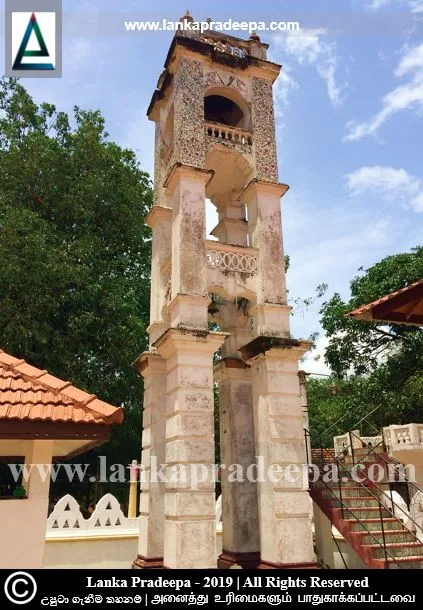
Kossinna Yatawatta Raja Maha Viharaya (Sinhala: කොස්සින්න යටවත්ත රජ මහා විහාරය) is a Buddhist temple located in the village of Kossinna in Gampaha District, Sri Lanka.
History
During the reign of King Parakramabahu VIII (1490-1509 A.D.), many Buddhist temples were built around the country. Jayapala Deva Pathiraja, one of the ministers of the king also engaged in establishing Buddhist temples in several places on the island. The Kossinna Raja Maha Viharaya in Gampaha District is believed to be one such temple established by Jayapala Deva Pathiraja (Chandananda Thera, 2009).
"Kossinna" is the village where the present temple is situated. The name, Kossinna is thought to have evolved from "Koswinna" meaning a grove of Jack trees (Gunasekara, 1887). According to popular beliefs, Jayapala Deva Pathiraja had removed a Madel forest that existed in the present temple area and grew a grove of Jack trees there (Chandananda Thera, 2009). He constructed a complete Buddhist temple (present Kossinna Viharaya) at a high ground within this grove and invited King Parakramabahu VIII to bestow it to Buddhist monks. The king who came for the bestowal ceremony ("Vihara Puja") planted a Bodhi tree at the place where the present Kudumirissa Viharaya stands and established a rock inscription at the same site to declare a royal decree (Chandananda Thera, 2009).
Image house
The image house of the Kossinna temple is archaeologically important and it is considered to be a structure belonging to the Kandyan Period (Dissanayaka, 2024). It is about 27.3 ft long, and 14.8 ft wide and has been built on an elevated rectangular-shaped platform (Lakmali et al., 2017).
A seated Buddha statue accompanied by two figures of Sariputta (left) and Moggallana (right), the two chief disciples of Gautama Buddha, are found inside the image house. Two standing statues of Buddha are also found facing each other on both left and right walls (Lakmali et al., 2017). The inner walls of the shrine contain no empty spaces and are filled with paintings of various decorative motifs. A "Makara Thorana"(a dragon arch) with the images of deities and doorkeepers adorn the front of the entrance wall. The outer walls, except the entrance wall, are not decorated with any sculptures or murals. The existing paintings and sculptures, according to their artistic features, belong to the Kandyan Period (Lakmali et al., 2017).
A protected site
The ancient image house, Devalaya and the Stupa located on the premises of Kossinna Raja Maha Vihara in the Grama Niladari Division of Kossinna in the Divisional Secretary’s Division of Gampaha are archaeological protected monuments, declared by a government Gazette notification published on 22 November 2002.




.
See also
#) Kossinna Ambalama
References
1) Chandananda Thera, R., 2009. Siyanepuren Siyaratata Abhimanayak Vu Yatawathu Vehera Ha Kossini Sanga Parapura (In Sinhala). Abhisthava. pp.XLIII-LI.
2) Dissanayaka, S. B., 2024. 2009 Varshaya Sandaha Puravidya Generalge Palana Varthawa (In Sinhala). Department of Archaeology. ISBN: 978-955-9159-70-4. p.102.
3) Gunasekara, M. B., 1887. Three Sinhalese Inscriptions: Text, transliteration, translation and notes#Inscription at Kudumirisa. Journal of the Ceylon Branch of the Royal Asiatic Society. Vol. X. No. 34. pp. 95-102.
4) Lakmali, A.S., Priyamali, A.S., Madhushani, E.P. and Chandrasiri, T.M.J., 2017. කොස්සින්න යටවත්ත රජමහ විහාරයෙහි ඇති ඉපැරණි විහාර මන්දිරය පිළිබඳව විමර්ශනයක්. 2nd Undergraduates' Research Conference 2017 (URACT). p.13.
5) The Gazette of the Democratic Socialist Republic of Sri Lanka. No: 1264. 22 November 2002.
2) Dissanayaka, S. B., 2024. 2009 Varshaya Sandaha Puravidya Generalge Palana Varthawa (In Sinhala). Department of Archaeology. ISBN: 978-955-9159-70-4. p.102.
3) Gunasekara, M. B., 1887. Three Sinhalese Inscriptions: Text, transliteration, translation and notes#Inscription at Kudumirisa. Journal of the Ceylon Branch of the Royal Asiatic Society. Vol. X. No. 34. pp. 95-102.
4) Lakmali, A.S., Priyamali, A.S., Madhushani, E.P. and Chandrasiri, T.M.J., 2017. කොස්සින්න යටවත්ත රජමහ විහාරයෙහි ඇති ඉපැරණි විහාර මන්දිරය පිළිබඳව විමර්ශනයක්. 2nd Undergraduates' Research Conference 2017 (URACT). p.13.
5) The Gazette of the Democratic Socialist Republic of Sri Lanka. No: 1264. 22 November 2002.
Location Map
This page was last updated on 16 May 2022
For a complete tourist map follow this link: Lankapradeepa Tourist Map
For a complete tourist map follow this link: Lankapradeepa Tourist Map
A short note for local school students
කොස්සින්න විහාරය
කොස්සින්න රජ මහා විහාරය යනු ශ්රී ලංකාවේ ගම්පහ දිස්ත්රික්කයේ කොස්සින්න ග්රාමයේ පිහිටි බෞද්ධ සිද්ධස්ථානයකි.
ඉතිහාසය8වන පරාක්රමබාහු රාජ්ය සමයේදී (ක්රි.ව. 1490-1509) රටපුරා විහාරස්ථාන රැසක් ඉදිවිය. රජුගේ අමාත්යවරයෙකු වූ ජයපාල දේව පතිරාජ ද රටෙහි සමහර ස්ථානයන්හී විහාර ඉදිකිරීමෙහි යෙදුනු අතර ගම්පහ පිහිටි කොස්සින්න විහාරයද ඔහු විසින් ඉදිකරන්නට යෙදුණු විහාරයක් සේ සැළකෙයි.
කොස්සින්න යනු වර්තමානයේ විහාරය පිහිටි ග්රාමය හඳුන්වන නාමය වේ. මෙම නාමය කොස් වනය යන අරුත් දෙන කොස්වින්න යන නාමයෙන් ව්යුත්පන්න වන්නට ඇතැයි විශ්වාස කෙරේ. වඩාත් ප්රචලිත විශ්වාසයට අනූව ජයපාල දේව පතිරාජ විසින් වත්මන් විහාරය පිහිටි ප්රදේශයේ වූ මාදෙල් වනයක් ඉවත් කොට කොස් ගොමුවක් වැවූ බව කියවේ. ඔහු විසින් මෙහි උස්වූ භූමියක සම්පූර්ණ විහාරයක් (වත්මන් කොස්සින්න විහාරය) කරවා එය සඟ සතු කරවීමට 8වන පරාක්රමබාහු රජුට ආරාධනා කොට තිබේ. විහාර පූජාවට පැමිණි රජු වත්මන් කුඩුමිරිස්ස විහාරය ඉදිකර ඇති ස්ථානයේ බෝධි වෘක්ෂයක් රෝපණය කරවා එහිම රාජකීය ආඥාවක් සහිත ශිලා ලේඛනයක් පිහිටුවන ලදී.
ප්රතිමා ගෘහයකොස්සින්න විහාරයෙහි ප්රතිමා ගෘහය පුරාවිද්යාත්මක වටිනාකමින් යුක්ත වේ. අඩි 27.3ක දිගකින් හා අඩි 14.8ක පළලින් යුතු මෙම ප්රතිමා ගෘහය උස් සෘජුකෝණාස්රාකාර හැඩැති වේදිකාවක් මත ගොඩනංවා ඇත.
ප්රතිමා ගෘහය තුල සැරියුත් (වම) හා මුගලන් (දකුණ) පිළිරූ දෙකකින් පරිවාර වූ හිඳි බුද්ධ ප්රතිමාවක් වේ. එකිනෙකා දෙස බලා හිඳින හිටි බුද්ධ ප්රතිමා දෙකක් දකුණු පස හා වම් පස බිත්ති මත දැකගත හැක. ගෘහයෙහි ඇතුල් බිත්ති විවිධ සිතුවම් හා මොස්තර වලින් පුරවා තිබෙන අතර ඇතුළුවන බිත්තියෙහි ඉදිරිපස මුහුණත දොරටුපාල රූප හා දේව රූප වලින් සමන්විත මකර තොරණකින් සරසා ඇත. වත්මන් සිතුවම් හා මූර්ති මහනුවර සම්ප්රදායෙහි කලා ලක්ෂණ වලින් සමන්විත වේ.
පුරාවිද්යා ස්මාරක ස්ථානයගම්පහ ප්රාදේශීය ලේකම් කොට්ඨාශයට අයත් කොස්සින්න විහාර භූමියෙහි පිහිටි පුරාණ ප්රතිමා ගෘහය, දේවාලය, සහ ස්තූපය 2002 නොවැම්බර් 22වන දින ප්රකාශයට පත් රජයේ ගැසට් නිවේදනය මගින් ආරක්ෂිත පුරාවිද්යා ස්මාරක ලෙස නම් කොට ඇත.



